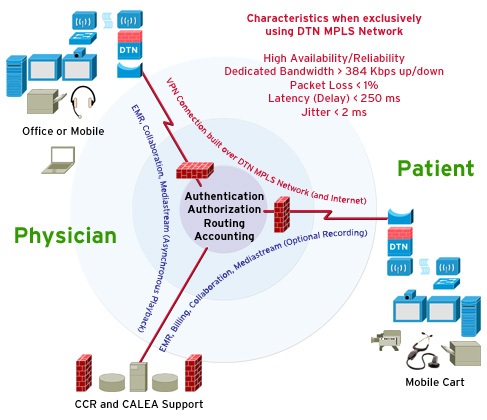 |
 Product & Services
Product & Services
The combination of our Telehealth Operations Center and network infrastructure, while supporting ISDN, also offers a superior video-grade IP alternative specifically engineered to deliver guaranteed TV quality video conferencing (constant 30 fps, synchronized audio/visual, and zero "tiling").
|
|
Security - SSL-based VPN for encrypted exchange between all parties on the link(s); NAT/PAT firewall enabled; HIPPA compliant network
|
|
Quality - End-to-end Quality of Service (QoS) guarantees when using the DTN MPLS network exclusively; degradation of service may occur when non-DTN network paths are used
|
|
Performance - Short latency to maintain interactivity; clear, accurate, color-specific imagery
|
|
Connectivity - Hetergeneous support of H.323 (IP) and H.320 (ISDN) participation in the same encounter; presence aware allowing find-me-follow-me of physicians
|
|
Simplicity - Ease of use engineered in
|
Telehealth End Point (TEP) includes moveable color video camera, used in conjunction with selected digital medical equipment peripherals:
- Exam Camera
- ENT Tips (supporting magnification)
- Stethoscope
- Vital Signs Monitor
- Pulse Oximeter
- Dermascope
- Ophthalmoscope
- Scale
- Glucose Meter
Connected over our state-of-the-art network.

|
 |
|
The DTN complete, turn-key solution comprises the audio/visual and digital medical equipment used at the Telehealth End Points (TEPs), the physical network infrastructure, and the Telehealth Operations Center (TOC); supporting a many-to-many clinical or educational encounter.

The physician initiates the encounter, our TOC identifies them, and determines whether the selected TEP is allowed, and if so what services are available at that TEP. This effectively, authenticates (biometric optional), authorizes, and then builds the appropriate secure connection(s).
By offering "presence-awareness" within our solution we can provide real-time information on who is available, what they can do (skill and equipment set), and which media they are available on, regardless of location.
Intelligent resource utilization together with prioritized transport of traffic ensures quality and performance. The audio/visual mediastream is given bandwidth priority over the datastream (medical device and patient data) to maintain good performance without jitter or loss.
In addition to clinical encounter connectivity DTN also provides integrated administrative infrastructure to support medical practice management. This includes Electronic Medical Record (EMR), transcription and billing services, collaboration, and scheduling.
Medical readings are not stored locally but forwarded securely through our TOC for storage in third-party EMR databases via industry standard Health Level 7 (HL7). Where required scanners/printers are provided to maintain the Continuity of Care Record when electronic storage is not an option.
By routing through our TOC all audio/visual encounter data is normalized (i.e. becoming equipment and transport protocol agnostic), and can be recorded, tagged, and stored for future retrieval.
It should be noted that while H.323 is currently the standard for video conferencing over IP and the accepted successor to ISDN (H.320), DTN believes that Session Initiation Protocol (SIP), will emerge as the new standard. It is through our use of SIP that DTN can uniquely provide "presence-awareness" as a value-add, and we move the focal point of the video encounter from the equipment to the people.
DTN is working with SIP and related technologies to produce a patient-centric, holistic, on-demand, healthcare encounter where telehealth truly delivers care to "anyone, anytime, anywhere". |